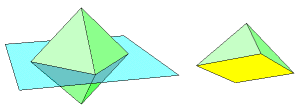
One example is that it can be used as a container since it has a large amount of space inside and its flat sides make it easier to stack multiple containers on top of each other. Finally, its net consists of 2 squares and 4 equilateral triangles. Its dual shapes are the cubical shape and the tetrahedral shape. It is one of the five platonic solids and can be seen as a degenerate form of a cube. It gets its name from Greek words for “eight” and “face” because it has 8 triangular faces. In conclusion, an octahedron is a polyhedral shape with 8 faces made up of 6 vertices and 12 edges. These relationships are explored in more depth below. The second example is between the octahedral shape and the tetrahedral shape which again can be seen in both a geometric and algebraic way. This can be seen in how they are related to each other geometrically as well as algebraically. The first example of this duality is between the octahedral shape and the cubical shape. Just like any other polyhedral shape, there is duality between the octahedral shape and another shape. You can see how this would look in the image below:ĭuality in Octahedral Shape (Octahedral and Cubical) (Octahedral and Tetrahedral) All the edges connect to form this shape without any gaps or overlaps. This net consists of 2 squares and 4 equilateral triangles put together. If you were to flatten out or “unfold” the octahedron, you would get what’s called a net of the octahedral shape. The 3 represents the 3 sides that each triangle has while the 4 means that there are 4 triangles meeting at each vertex. Therefore, there are 12 edges on an octahedron.Īn octahedron can be described by its face-vertex configuration or F-V configuration. 4 of them meet at each vertex.Įach face meets another at an edge. FacesĪn octahedron has 8 faces, made up of 6 vertices and 12 edges. The word "octahedron" comes from the Greek words for "eight" and "face".

If you cut them along the plane that cuts through the middle of the edge connecting the two pyramids, you would get two identical tetrahedra. Octahedra are usually portrayed as two square pyramids joined at the base. It is one of the five Platonic solids, and the only one with fewer than 5 faces. A cube can be seen as a degenerate octahedron with all edges and angles equal. A regular octahedron is a Platonic solid composed of eight equilateral triangles, four of which meet at each vertex. In geometry, an octahedron is a polyhedron with eight faces.


 0 kommentar(er)
0 kommentar(er)
